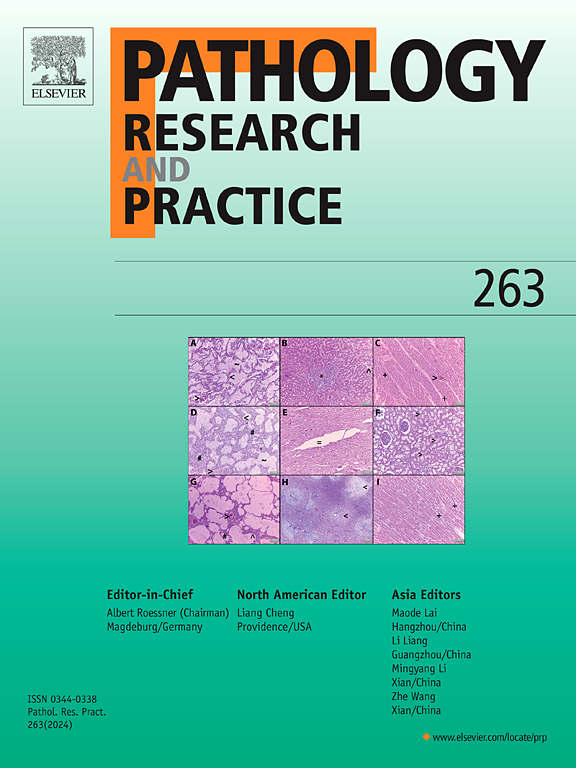Single-cell transcriptomic analyses provide insights into the tumor microenvironment heterogeneity and invasion phenotype in retinoblastoma
IF 2.9
4区 医学
Q2 PATHOLOGY
引用次数: 0
Abstract
Background
As the most common intraocular malignant tumor, retinoblastoma (RB) is associated with high mortality during early childhood. The heterogeneous cellular composition of the tumor microenvironment (TME) plays a pivotal role in modulating immune responses, tumor growth and metastasis progression. However, the landscape of TME heterogeneity and cell-cell communication networks in RB remain poorly characterized.
Methods
Different phenotypes of RB were characterized by integrated single-cell sequencing data. Cellular subclusters of three principal TME components were systematically identified. CellChat analyzed package was employed to depict intercellular communications across all types of cells in TME. Next, pseudotime trajectory analyses were performed with Monocle package. CIBERSORT algorithms (LM22 signature matrix) and CIBERSORTx platform were employed to characterize immune cell infiltration landscape from microarray data. Finally, functional enrichment profiling elucidated associations between TME subcluster signatures and extraocular invasion phenotypes of RB.
Results
Characteristic subclusters of TME components, such as MG1 in tumor-associated macrophages (TAMs) and AC1 in astrocyte-like cells were probably associated with RB extraocular invasion in different ways. And RB invasive progression might be relevant with the cell-cell communications landscape change between TME-related cell populations. Trajectory analysis revealed the potential correlation of RB invasion with the increase of immature TAMs and the decrease of terminally differentiated astrocyte-like cells. Functional enrichment analysis further profiled the distinct molecular feature of characteristic subclusters.
Conclusions
This study systematically delineates TME heterogeneity landscapes across non-invasive versus invasive RB, providing mechanistic insights into intercellular communications within TME. Our findings might have the potential to develop microenvironment-targeted therapeutic strategies in RB management.
单细胞转录组学分析为视网膜母细胞瘤的肿瘤微环境异质性和侵袭表型提供了见解
背景视网膜母细胞瘤(retinoblastoma, RB)是最常见的眼内恶性肿瘤,儿童早期死亡率高。肿瘤微环境(tumor microenvironment, TME)的异质性细胞组成在调节免疫应答、肿瘤生长和转移进展中起着关键作用。然而,RB中TME异质性和细胞-细胞通信网络的特征仍然很差。方法利用整合的单细胞测序数据对RB的不同表型进行表征。系统地鉴定了三个主要TME成分的细胞亚簇。使用CellChat分析包来描述TME中所有类型细胞的细胞间通信。接下来,使用Monocle软件包进行伪时间轨迹分析。采用CIBERSORT算法(LM22签名矩阵)和CIBERSORTx平台从微阵列数据中表征免疫细胞浸润景观。最后,功能富集分析阐明了TME亚簇特征与RB眼外侵袭表型之间的关联。结果肿瘤相关巨噬细胞(tumor-associated macrophages, tam)中的MG1和星形细胞样细胞(astrocyte-样cells)中的AC1等TME组分的特征性亚群可能以不同的方式与RB眼外侵袭有关。RB侵袭性进展可能与tme相关细胞群之间的细胞间通讯景观变化有关。轨迹分析显示RB侵袭与未成熟tam的增加和终末分化星形细胞样细胞的减少有潜在的相关性。功能富集分析进一步描绘了特征亚簇的独特分子特征。本研究系统地描述了非侵入性和侵入性RB的TME异质性景观,为TME细胞间通讯提供了机制见解。我们的研究结果可能有潜力开发针对RB管理的微环境治疗策略。
本文章由计算机程序翻译,如有差异,请以英文原文为准。
求助全文
约1分钟内获得全文
求助全文
来源期刊
CiteScore
5.00
自引率
3.60%
发文量
405
审稿时长
24 days
期刊介绍:
Pathology, Research and Practice provides accessible coverage of the most recent developments across the entire field of pathology: Reviews focus on recent progress in pathology, while Comments look at interesting current problems and at hypotheses for future developments in pathology. Original Papers present novel findings on all aspects of general, anatomic and molecular pathology. Rapid Communications inform readers on preliminary findings that may be relevant for further studies and need to be communicated quickly. Teaching Cases look at new aspects or special diagnostic problems of diseases and at case reports relevant for the pathologist''s practice.

 求助内容:
求助内容: 应助结果提醒方式:
应助结果提醒方式:


